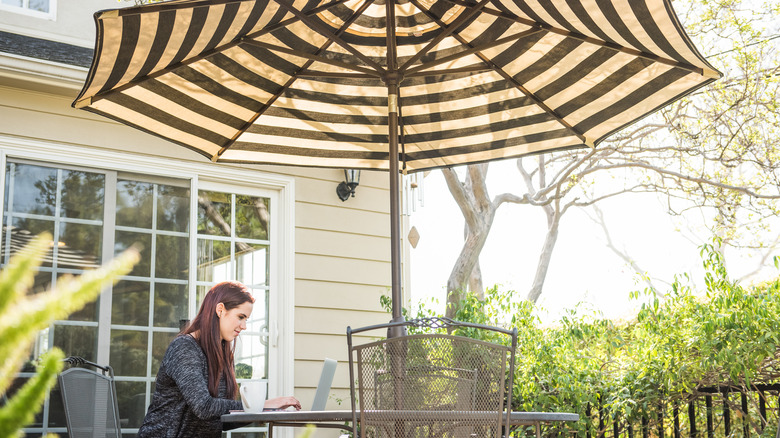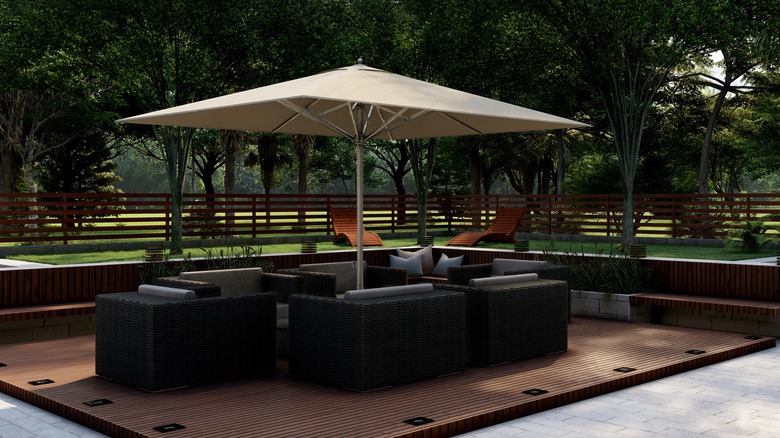Here's How To Pick The Right Patio Umbrella Size And Shape
Transforming your outdoor space into a comfortable oasis is a delightful way to enjoy the beauty of nature while seeking respite from the sun's harsh rays. And when it comes to creating a shaded retreat, a patio umbrella is a stylish and practical solution. However, selecting the right size and shape requires thoughtful consideration to ensure it complements your outdoor setting. These aspects are crucial in an umbrella's functionality and aesthetic appeal.
There are several factors to consider concerning patio umbrella size: the size of your outdoor space, the number of people you intend to accommodate, and the desired coverage area. Beyond size, the shape of the patio umbrella also impacts its overall look and functionality. Each profile brings a distinct charm, from classic round and square designs to elegant rectangular and octagonal options. In making your decision, climate considerations, furniture layout, personal style, budget constraints, and maintenance requirements also come into play.
Exploring sizes and shapes
Patio umbrellas come in various sizes, and understanding the measurement system is critical to selecting the right one for your outdoor space. Although manufacturers' specifications vary, the most common measurement used is the diameter, which refers to the width of the umbrella when fully opened. When determining an appropriate size for your patio, consider the size of your outdoor space. For example, a small balcony may require a compact umbrella, while a spacious deck can accommodate a larger one for ample shade. The number of people you intend to shelter is another crucial factor. Taking measurements and considering the arrangement of your outdoor furniture will help you determine the appropriate size.
Next, consider the array of shapes and unique designs to choose from. A round umbrella offers a classic and versatile design for smaller spaces. Square ones provide a modern, symmetrical look, ideal for square or rectangular tables. Rectangular models are excellent for elongated outdoor spaces, while octagonal designs can be incredibly versatile, working well in a variety of outdoor settings. Finally, cantilever or offset umbrellas have an off-center pole, allowing for flexible positioning and unobstructed shade without interfering with furniture arrangement.
Other key considerations for a patio umbrella
When selecting the design of your patio umbrella, it's vital to take into account the weather conditions in your area. If you experience strong winds, you may need a sturdier and more wind-resistant model. In areas with intense sunlight, a large umbrella (or one with excellent UV protection) is a wise choice.
Your personal preferences also play a significant role in selecting the right product. First, consider the overall look you want to achieve. Next, set a budget for your patio umbrella purchase. Keep in mind that larger designs and those with additional features may be pricier. Consider the long-term value and durability of the product to make an informed decision within your budget. Also, don't forget to think about factors such as cleaning, disassembly, and storage space availability before deciding.
However, the considerations shouldn't stop there. Different frame materials, such as aluminum, wood, or fiberglass, offer varying durability and aesthetics. Fabric choice is also crucial, affecting UV protection, water resistance, and longevity. Finally, consider additional features that enhance functionality and convenience. For example, tilt mechanisms allow you to adjust the angle of the shade, while a crank system makes it easier to open and close the umbrella. The perfect umbrella will not only provide shade but also become an integral part of your outdoor oasis.


